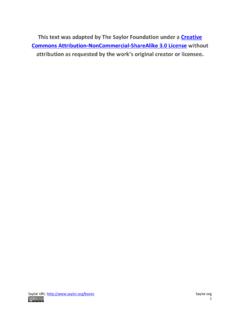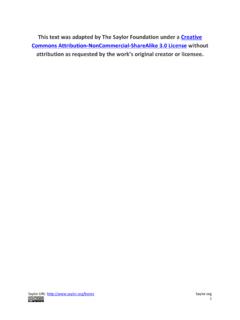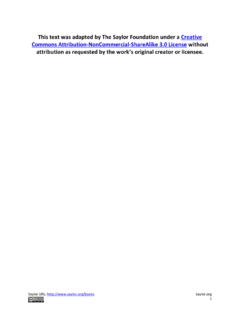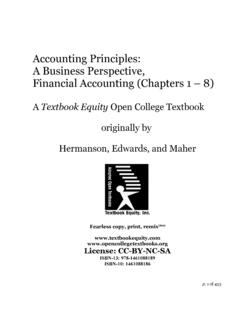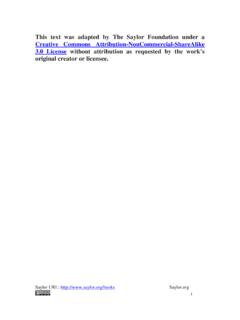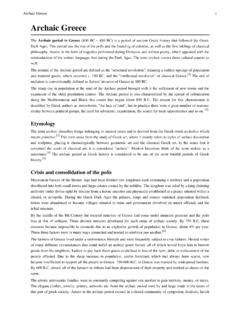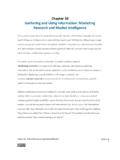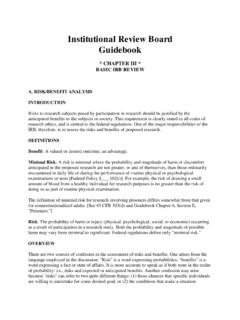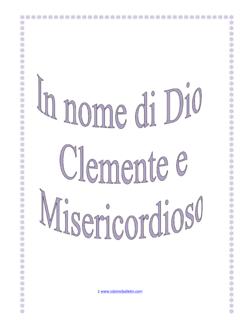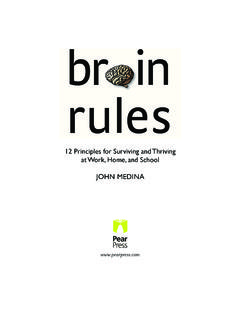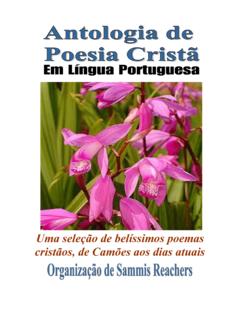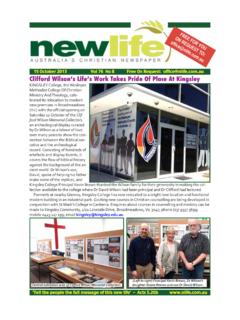Transcription of Cell theory - Saylor Academy
1 Cell theory1 Cell theoryA prokaryoteCell theory refers to the idea that cells arethe basic unit of structure in every livingthing. Development of this theory during themid 17th century was made possible byadvances in microscopy. This theory is oneof the foundations of biology. The theorysays that new cells are formed from otherexisting cells , and that the cell is afundamental unit of structure, function andorganization in all living theory2 HistoryDrawing of the structure of cork by Robert Hooke that appeared inMicrographiaThe cell was discovered by Robert Hooke in 1665.
2 Heexamined (under a coarse, compound microscope)very thin slices of cork and saw a multitude of tinypores that he remarked looked like the walledcompartments of a honeycomb. Because of thisassociation, Hooke called them cells , the name theystill bear. However, Hooke did not know their realstructure or function.[1] Hooke's description of thesecells (which were actually non-living cell walls) waspublished in Micrographia.[2] . His cell observationsgave no indication of the nucleus and other organellesfound in most living first man to witness a live cell under a microscopewas Antony van Leeuwenhoek (although the first manto make a compound microscope was ZachariasJanssen), who in 1674 described the algae Spirogyraand named the moving organisms animalcules,meaning "little animals".
3 [3] . Leeuwenhoek probablyalso saw bacteria.[4] cell theory was in contrast to thevitalism theories proposed before the discovery idea that cells were separable into individual unitswas proposed by Ludolph Christian Treviranus[5] andJohann Jacob Paul Moldenhawer[6] . All of this finallyled to Henri Dutrochet formulating one of thefundamental tenets of modern cell theory by declaring that "The cell is the fundamental element of organization"[7]The observations of Hooke, Leeuwenhoek, Schleiden, Schwann, Virchow, and others led to the development of thecell theory .
4 The cell theory is a widely accepted explanation of the relationship between cells and living things. Thecell theory states: All living things or organisms are made of cells . New cells are created by old cells dividing into two. cells are the basic building units of cell theory holds true for all living things, no matter how big or small, or how simple or complex. Sinceaccording to research, cells are common to all living things, they can provide information about all life. And becauseall cells come from other cells , scientists can study cells to learn about growth, reproduction, and all other functionsthat living things perform.
5 By learning about cells and how they function, you can learn about all types of for developing cell theory is usually given to three scientists: Theodor Schwann, Matthias Jakob Schleiden,and Rudolf Virchow. In 1839, Schwann and Schleiden suggested that cells were the basic unit of life. Their theoryaccepted the first two tenets of modern cell theory (see next section, below). However the cell theory of Schleidendiffered from modern cell theory in that it proposed a method of spontaneous crystallization that he called "Free CellFormation"[8].
6 In 1858, Rudolf Virchow concluded that all cells come from pre-existing cells , thus completing theclassical cell theory3 Classical living organisms are made up of one or more are the basic unit of cells arise from pre-existing cells .(omni cellulae e cellula) cell is the unit of structure, physiology, and organization in living cell retains a dual existence as a distinct entity and a building block in the construction of interpretationThe generally accepted parts of modern cell theory cell is the fundamental unit of structure and function in living cells arise from pre-existing cells by flow (metabolism and biochemistry) occurs within contain hereditary information (DNA)
7 Which is passed from cell to cell during cell cells are basically the same in chemical composition in organisms of similar known living things are made up of one or more organisms are made up of only one cell and are known as unicellular are multicellular, composed of a number of activity of an organism depends on the total activity of independent are considered alive by some, yet they are not made up of cells . Viruses have many features of life, butby definition of the cell theory , they are not first cell did not originate from a pre-existing cell.
8 There was no exact first cell since the definition of cell and chloroplasts have their own genetic material, and reproduce independently from the rest of of cellsCells can be subdivided into the following : Prokaryotes lack a nucleus (though they do have circular DNA) and other membrane-boundorganelles (though they do contain ribosomes). Bacteria and Archaea are two domains of : Eukaryotes, on the other hand, have distinct nuclei bound by a nuclear membrane andmembrane-bound organelles (mitochondria, chloroplasts, lysosomes, rough and smooth endoplasmic reticulum,vacuoles).
9 In addition, they possess organized chromosomes which store genetic also Cell biology Cell division Cell signaling Cell adhesion Cellular differentiationCell theory4 References[1]Inwood, Stephen (2003). The man who knew too much: the strange and inventive life of Robert Hooke, 1635-1703. London: Pan. pp. 0-330-48829-5.[2]Karling JS (1939). "Schleiden's Contribution to the cell theory ". The American Naturalist 73: 517 37. [3]Moll WAW (2006). "Antonie van Leeuwenhoek" (http:/ / web. archive. org/ web/ 20080602095555/ http:/ / www. euronet.)
10 Nl/ users/ warnar/leeuwenhoek. html#references). Archived from the original (http:/ / www. euronet. nl/ users/ warnar/ leeuwenhoek. html#references) on2008-06-02.. Retrieved 2008-11-25.[4]Porter JR (June 1976). "Antony van Leeuwenhoek: tercentenary of his discovery of bacteria" (http:/ / mmbr. asm. org/ cgi/pmidlookup?view=long& pmid=786250). Bacteriol Rev 40 (2): 260 9. PMID 786250. PMC 413956..[5]Treviranus, Ludolph Christian 1811, "Beytr ge zur Pflanzenphysiologie"[6]Moldenhawer, Johann Jacob Paul 1812, "Beytr ge zur Anatomie der Pflanzen"[7]Dutrochet, Henri 1924, "Recherches anatomiques et physiologiques sur la structure intime des animaux et des vegetaux, et sur leur motilite,par Dutrochet, avec deux planches" (http:/ / books.
